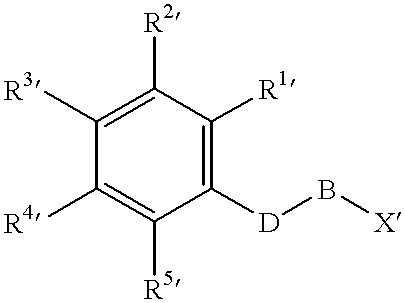Prodrugs activated by targeted catalytic proteins
- Summary
- Abstract
- Description
- Claims
- Application Information
AI Technical Summary
Benefits of technology
Problems solved by technology
Method used
Image
Examples
example 1a
Preparation of the Experimental Prodrugs, Linear trimethylbenzoyl- and trimethoxybenzoyl-5-fluorouridine, Compounds 1a and 1b
5'-O-(2,4,6-Trimethylbenzoyl)-5-fluorouridine 1a and 5'-O-(3,4,5-Trimethoxybenzoyl)-5-fluorouridine 1b (For individual reference, compound numbers in bold in the following text refer to the compounds in the synthetic schemes shown in the figures.) Refer to FIG. 1a for the bold numbered compounds in this Example.
The preparation of 5'-O-(2,4,6-trimethylbenzoyl)-5-fluorouridine 1a and 5'-O-(3,4,5-trimethoxybenzoyl)-5-fluorouridine 1b was achieved with the reaction of 2,4,6-trimethylbenzoyl-chloride and 3,4,5-trimethoxybenzoyl chloride with 2',3'-O-isopropylidene-5-fluorouridine 65 (prepared in Example 16) in pyridine followed by acid hydrolysis with 50% formic acid at 65.degree. C.
In detail, the synthesis is as follows:
5'-O-(2,4,6-Trimethylbenzoyl)-5-fluorouridine 1a
A mixture of 328 mg of 2,4,6-trimethylbenzoic acid and 3 mL of thionyl chloride was stirred at roo...
example 1b
Preparation of the Hapten of the Prodrug in Example 1a, the Linear Phosphonate of trimethoxybenzoate-5-fluorouridine, Compound 4
Refer to FIG. 1b for the bold numbered compounds in this Example.
Uridine was iodinated at the 5 position to give iodide 3a (Robins, J. M., et al., Can. J. Chem. 60 (1982):554-557). The hydroxyl groups were protected to give iodide 3c. 3-Butyne-1-ol was transformed in four steps to alkyne 3d. Alkyne 3d and iodide 3c are coupled using a Pd(II) catalyst to give nucleoside analog 3e (Robins, J. J., et al., J. Org. Chem. 48 (1983):1854-1862). Selective deprotection gives alcohol 3f.
Dibenzyl 3,4,5-trimethoxyphenylphosphonate 2 can be prepared from the reaction of 3,4,5-trimethoxybromobenzene with dibenzyl phosphite at high temperature in the presence of tetrakis(triphenylphosphine)palladium (0), triethylamine and toluene following the procedure of J. Med. Chem. 32 (1989):1580-1590. Reaction of diester 2 with 1 equivalent of PC1.sub.5 gives monochloridate 2a, whic...
example 2a
Preparation of Experimental Prodrug, Intramolecular trimethoxybenzoate-5-fluorouridine, Compound 10
Refer to FIG. 2a for the bold numbered compounds in this Example.
The bromobenzoic acid 5, whose preparation is described in Example 8a, undergoes lithium-halogen exchange and is alkylated with protected iodoethanol 7 (see FIG. 2a). The product 8 is dehydrated to form the symmetric anhydride, which is reacted with 5-fluorouridine to form a stable prodrug precursor, 9. The protecting group of the precursor can be removed rapidly to give the prodrug 10.
In detail the synthesis is as follows:
2-Bromoethyl 4,4'-dimethoxytriphenylmethyl ether 6
DMAP (100 mmol) is added to a solution of 2-bromoethanol (100 mmol) and 4,4'-dimethoxytriphenylmethyl chloride (100 mmol) in DMF (100 mL) at room temperature. After 16 hours, the mixture is poured into water (300 mL) and extracted with ethyl acetate (3.times.100 mL). The organic phases are washed with water (100 mL), dried over anhydrous Na.sub.2 SO.sub....
PUM
| Property | Measurement | Unit |
|---|---|---|
| Volume | aaaaa | aaaaa |
| Volume | aaaaa | aaaaa |
| Volume | aaaaa | aaaaa |
Abstract
Description
Claims
Application Information
 Login to View More
Login to View More - R&D
- Intellectual Property
- Life Sciences
- Materials
- Tech Scout
- Unparalleled Data Quality
- Higher Quality Content
- 60% Fewer Hallucinations
Browse by: Latest US Patents, China's latest patents, Technical Efficacy Thesaurus, Application Domain, Technology Topic, Popular Technical Reports.
© 2025 PatSnap. All rights reserved.Legal|Privacy policy|Modern Slavery Act Transparency Statement|Sitemap|About US| Contact US: help@patsnap.com



